The buzz around Web3 e-commerce is impossible to ignore. The evolution of the World Wide Web promises to change business approaches by introducing decentralization, transparency, enhanced user control, and AI integration.
Web3 integration will deeply influence ecommerce as well, changing the manner in which businesses communicate with, sell to, and engage customers. As the analysis of ecommerce and retail markets informs, Web3 ecommerce is predicted to grow at a CAGR of 45.80% from USD 4.2 billion in 2022 to USD 55.32 billion by 2032 thanks to the expanding use of blockchain, the emergence of decentralized entertainment platforms, cryptocurrencies, and high demand for better customer interaction.
Considering all these trends, to stay competitive and keep success in online retail over the next 5 years, it’s better to think about which Web3 technologies you can adopt today while planning your e-commerce project.
At Rubyroid Labs, we specialize in integrating the newest technologies into projects from the ground up, always keeping your specific business goals and objectives in mind. Let’s start a conversation and turn your innovative plan into a real solution.
This blog post will tell how Web3 is set to reshape ecommerce, as well as provide details on the possibilities and challenges that online businesses will face.
Contents
- Unlocking Web3 and Its Previous Versions: Web 2.0 and Web 1.0
- Web3 Ecommerce: What Technologies Web3 Will Bring into Online Retail
- Benefits and Potential Challenges of Web 3.0 for Ecommerce
- Use Cases of Web3 Ecommerce Applications
- Preparing Your Business for Web3 Ecommerce: Steps to Take Now
- Wrapping Up
Unlocking Web3 and Its Previous Versions: Web 2.0 and Web 1.0
Web3 is the next big step for the internet, though it’s still in development. Think of it as the internet’s developing framework, which is not quite complete. To adapt to developing trends and technology, all factors must be thoroughly tested, which takes time.
Web 1.0: The foundational internet that focused—it’s the first version of the internet, with a primary focus on visual presenting information. This is where ecommerce was born and started with online catalogs.
Web 2.0: The interactive internet—it’s our present-day internet where we can chat, exchange content, and shop online. It reflects our current digital world, in which we conduct online purchases but often must share our personal data with large corporations like Google, Apple, Alibaba, and Amazon before we can fully enjoy our online shopping experience and choose products we’re interested in.
Web 3.0: The decentralized internet—the next-generation internet, aiming to be smarter, safer, and give users greater control. This is the vision for future online interactions, including ecommerce: a more private shopping experience free from centralized monitoring. A direct, secure, and decentralized internet—this is the mission of Web 3.0.

The new Web3 internet aims to be far different from the existing version in its architecture. It offers a new digital world that uses blockchain technology and concepts like decentralization and token-based economy for superior user experience.
Web3 aims to eliminate dependency on intermediaries or centralized platforms such as Google or Facebook, which appeals to individuals who value digital independence. It proposes a user-centered internet architecture in which people have more control over their digital presence and data.
Web 3.0 will also reduce the need for classic third-party intermediaries to conduct virtual transactions, with blockchain technology offering payment reliability and safety.
Let’s have a look at how Web3 differs from the present Web2 by features in the table below.
| Feature | Web 2.0 | Web 3.0 |
| Data Ownership | Centralized (controlled by big tech companies) | Decentralized (user-owned and controlled) |
| Privacy | Limited user control | Enhanced user control and privacy |
| Architecture | Client-Server | Peer-to-Peer |
| Main Technologies | Cloud computing, social media, mobile apps | Blockchain, AI, machine learning, IoT |
| Transactions | Requires intermediaries (banks, payment processors) | Direct peer-to-peer transactions |
| Identity Management | Multiple accounts across platforms | Decentralized identity (single identity across platforms) |
| Data Storage | Centralized servers | Distributed across network nodes |
| Governance | Controlled by corporations | Community-driven (e.g., decentralized autonomous organizations) |
| Interoperability | Limited between platforms | Enhanced data portability and interoperability |
| Monetization | Ad-driven, platform-controlled | Direct creator-to-consumer, tokenization |
| Applications | Centralized apps (e.g., Facebook, Amazon) | Decentralized apps (dApps) |
Web3 Ecommerce: What Technologies Web3 Will Bring into Online Retail
There are differing opinions on the Web3’s influence on e-commerce. While some specialists are skeptical, others believe the next internet generation will be completely diverse, as it will provide entirely new methods for marketing, selling, engaging, and communicating online.
We at Rubyroid Labs are convinced that Web3 is going to usher in a new future with secure, personalized, and transparent shopping, making it smarter and more efficient for both businesses and customers. Here are the key technologies that Web3 is introducing to ecommerce:
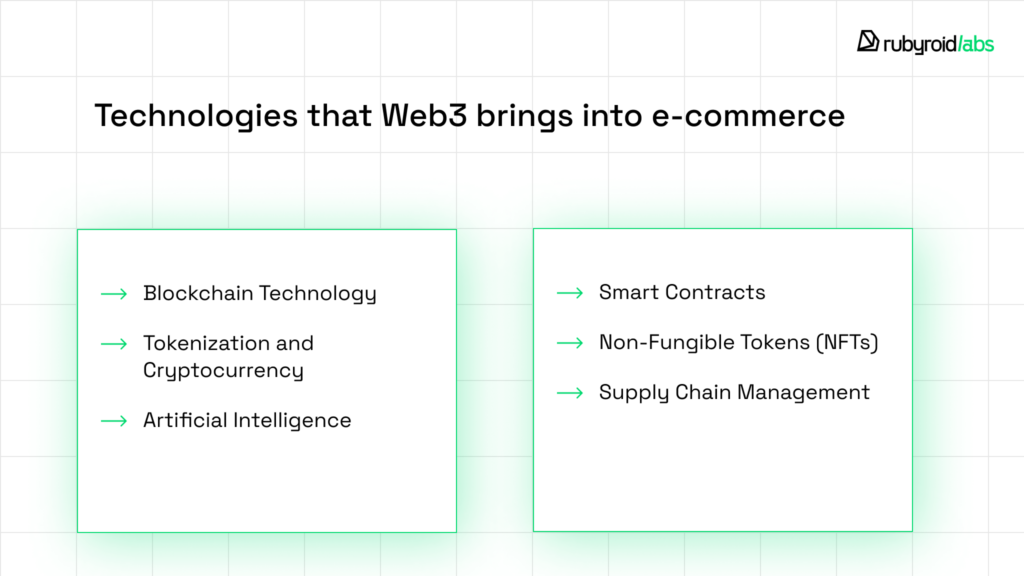
Tokenization and Cryptocurrency
Tokenization is the process of turning ownership or rights to assets, such as real estate, artwork, or company shares, into their valuable digital versions – tokens that can be managed and stored on a blockchain.
Cryptocurrency is a form of digital money that relies on highly secure encryption and is based on blockchain technology. Cryptocurrency is important in Web3 ecommerce because it allows for safe, rapid, and borderless transactions that do not require traditional financial intermediaries. It enables internet companies to take payments from anywhere in the world at lower rates and processing times.
Blockchain Technology
Blockchain is a distributed ledger system that keeps data in a unique manner. It is a chain of blocks, each carrying a set of transactions or other data.
Every time something important, like a purchase or a transfer, takes place, it is documented in a new block. This block is then added to the chain and connected to all of the previous blocks.
The unique characteristic of blockchain is that copies of the whole chain are stored on several computers in the world. This makes it extremely secure and virtually hard to tamper with because the data can be easily verified across numerous sources.
Non-Fungible Tokens (NFTs)
NFTs represent unique digital assets on the blockchain. In ecommerce, NFTs can be used for digital product authentication, exclusive memberships, virtual goods in metaverse marketplaces, and loyalty programs. They offer new ways for brands to engage with customers and create unique, verifiable digital experiences.
Smart Contracts
Smart contracts are digital agreements that run automatically on a blockchain. They’re computer programs designed to make specific actions when certain conditions are met without needing human intervention.
Supply Chain Management
As for supply chain, Web3 makes it more efficient and transparent. Blockchain enables instant, accurate tracking of products through every stage of the supply chain. This increased visibility allows customers to easily verify the authenticity and origin of products, reducing counterfeiting. Smart contracts can automate restocking and manage just-in-time inventory, reducing waste and improving efficiency. The enhanced transparency also facilitates sustainable and ethical sourcing, meeting growing consumer demands for responsible production. Furthermore, decentralized networks can optimize shipping routes and improve coordination between different parts of the supply chain, streamlining logistics operations.
Artificial Intelligence
Artificial intelligence (AI) is already transforming online shopping by making it smarter and more intuitive. AI-powered chatbots and virtual assistants provide round-the-clock customer help and tailored shopping suggestions, improving the user experience. Predictive analytics anticipates consumer requirements and optimizes inventory management, while image recognition technology enhances product visual search capabilities. These AI technologies are revolutionizing ecommerce platforms by automating processes and providing more compelling shopping experiences.
At Rubyroid Labs, our team provides ChatGPT integration services, including chatbot development, ChatGPT API integration, and automation for various services.
As all these technologies mature and become more widely adopted, we can expect to see a significant boost in how online retail operates, benefiting both businesses and consumers in this new digital era.

Benefits and Potential Challenges of Web 3.0 for Ecommerce
Web3 technologies, including AI and machine learning, cryptocurrency and NFTs, have already made significant changes in the ecommerce sector. For example, 37% of US ecommerce vendors accept cryptocurrency as a payment method, which is 10 points higher than in 2022. As for revenue growth in the USA, the projected annual growth rate (CAGR 2024-2028) from the use of cryptocurrencies is expected to reach US $33 billion by 2028.
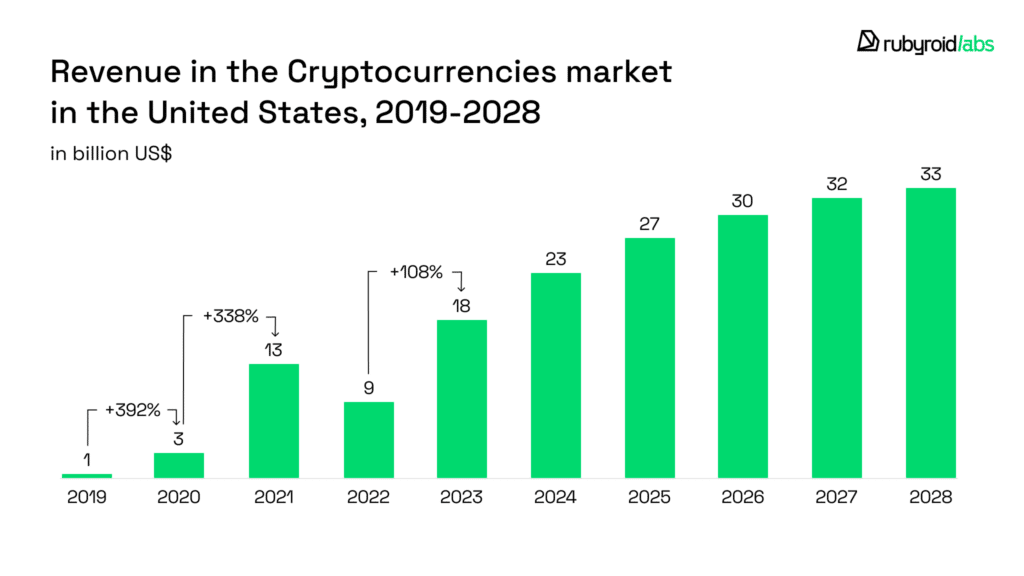
Another fact, the value of AI technology in online retail is forecast to rise from 1,714.3 million in 2021 to USD 36,462.5 million in 2025.
So, we’re witnessing real-world applications that are reshaping how online businesses operate and how consumers interact with them. It’s exciting and overwhelming at the same time, though having both benefits and some challenges. Let’s analyze each of the points and make conclusions.
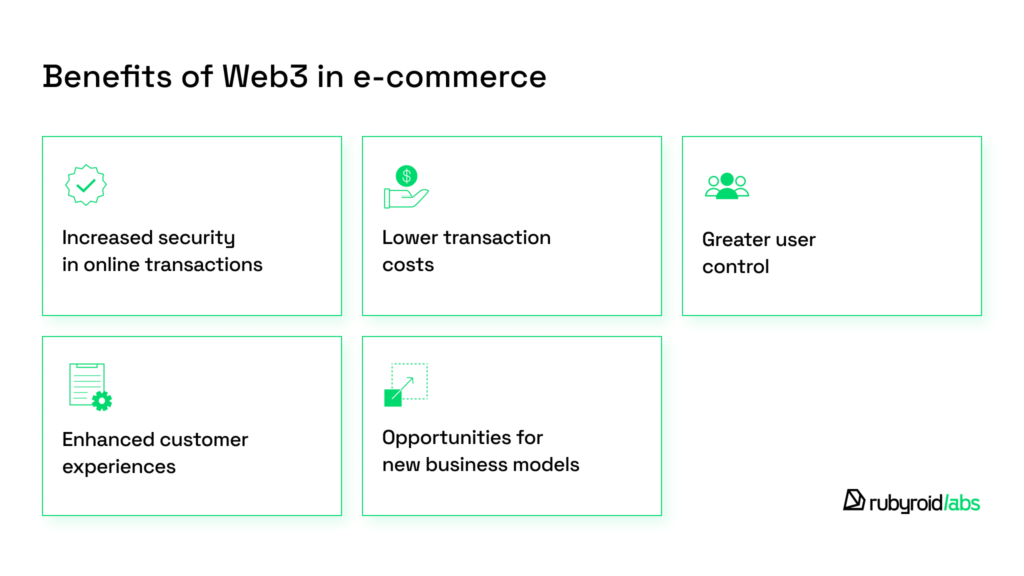
Benefits of Web3 in Ecommerce
- Increased security in online transactions
Blockchain technology in Web 3.0 ensures that transaction records are safe, transparent, and immutable. This improved security boosts consumer trust, minimizing fraud and chargebacks. Smart contracts can automate and protect complicated transactions, raising the reliance of online business.
- Greater user control
Web 3.0 focuses on data ownership and privacy. Customers can have greater control over their personal information by deciding what to share and with whom. This move may lead to more open and safe data handling in ecommerce, resulting in greater customer relationships.
- Lower transaction costs
Decentralized systems and cryptocurrencies can significantly cut transaction costs by removing intermediaries. Furthermore, blockchain-based transactions may be executed even faster than traditional banking systems, stimulating cash flow for businesses and increasing customer satisfaction.
- Opportunities for new business models
Web 3.0 opens new business models such as decentralized marketplaces, tokenized loyalty programs, and NFT-based digital products. These channels may open new ways of making money and provide new opportunities for companies to interact with customers.
- Enhanced customer experiences
With AI and machine learning advancements, Web 3.0 can offer hyper-personalized shopping experiences. From product recommendations to customized interfaces, businesses can create unique, engaging interactions that cater to individual preferences and needs.
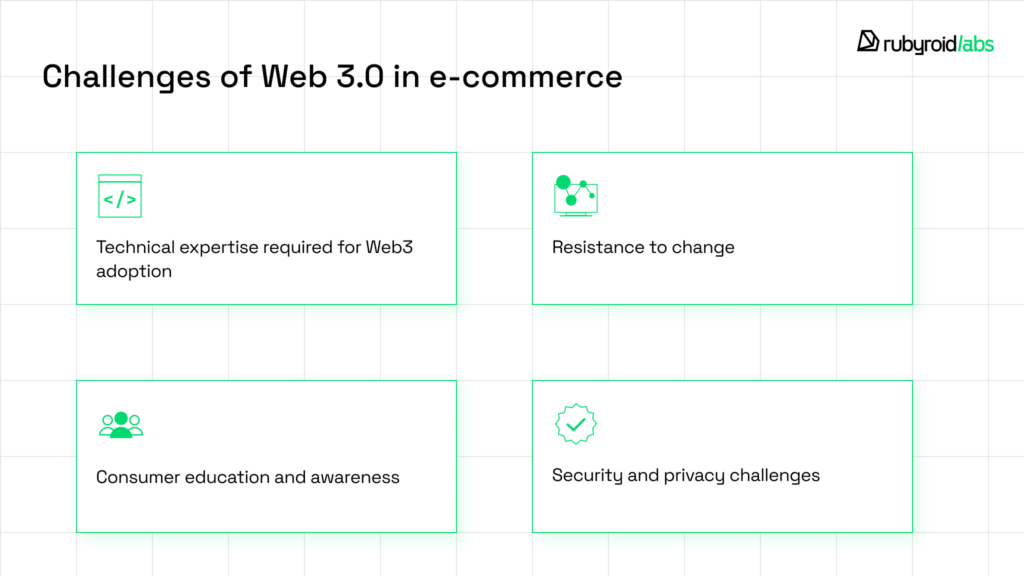
Challenges of Web 3.0 in Ecommerce
- Technical expertise required for Web3 adoption
Adopting Web 3.0 technology involves special technical knowledge and infrastructure adjustments. In addition, the legal environment for cryptocurrencies and blockchain technology is always changing, causing uncertainty for companies seeking to deploy these solutions.
- Resistance to change
Existing ecommerce giants may resist the transition to Web 3.0 as it affects their present business structures and market domination. This conflict may delay adoption and split the market.
- Consumer education and awareness
Many customers are not aware with Web 3.0 ideas such as blockchain, cryptocurrency, and decentralized platforms. Businesses will need to invest in informing their consumers about the benefits of these technologies in order to encourage adoption.
- Security and privacy challenges
Web 3.0 promises to improve security, but it also poses new threats. Smart contract weaknesses, cryptocurrency volatility, and the irreversibility of blockchain transactions are all issues that must be addressed. Furthermore, the relationship between data privacy and personalization will need careful consideration.
Web 3.0 presents a transformative opportunity for ecommerce, offering enhanced security, efficiency, and personalization. However, businesses must be prepared to overcome technical, regulatory, and educational hurdles to fully leverage these benefits. As the technology matures and adoption grows, we can expect to see innovative solutions that address these challenges, paving the way for a new era of online commerce.
Use Cases of Web3 Ecommerce Applications
As the use of Web3 technology grows, we can expect to see even more innovative uses of blockchain and related technologies in online retail. Here are some prominent examples of Web3 e-commerce applications:
ChainGPT
ChainGPT is an innovative AI model that’s transforming smart contract development and interaction. This advanced system allows users to create and deploy smart contracts without needing coding expertise. Beyond creation, ChainGPT offers valuable assistance in debugging, analyzing, and optimizing smart contracts, helping ensure their security and efficiency.
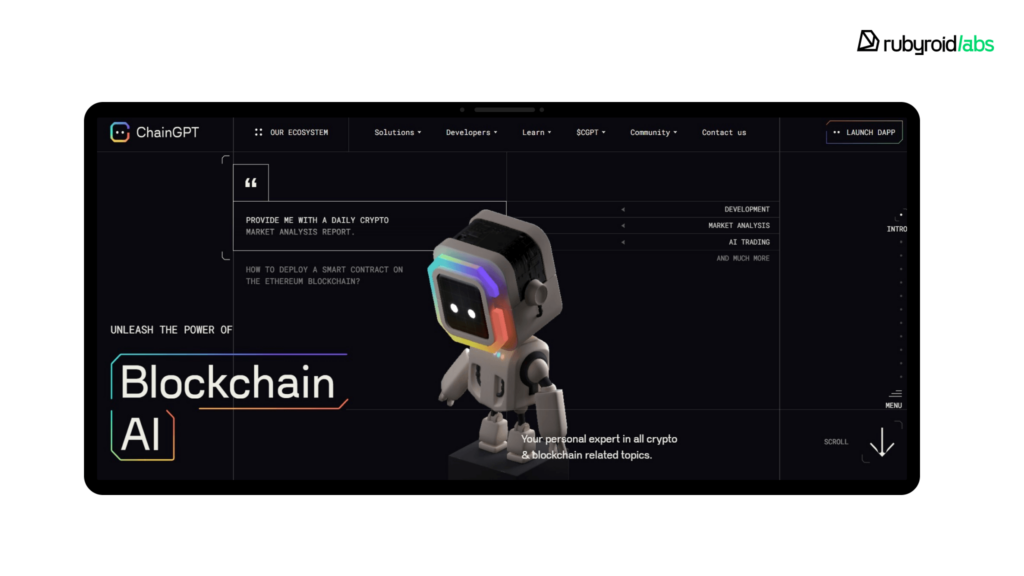
Shopify NFT App
The Shopify NFT App is a user-friendly tool that seamlessly integrates NFT (Non-Fungible Token) creation and sales into existing Shopify stores. This innovative app allows merchants to dive into the world of digital collectibles without requiring any coding skills or in-depth knowledge of cryptocurrency.

OpenSea
OpenSea is a platform based on the decentralized principles of Web3 that acts as a marketplace for buying and selling non-fungible tokens (NFTs). Built on the Ethereum blockchain, it eliminates the need for centralized intermediaries. The platform uses smart contracts for fast transactions, guaranteeing users security and transparency.
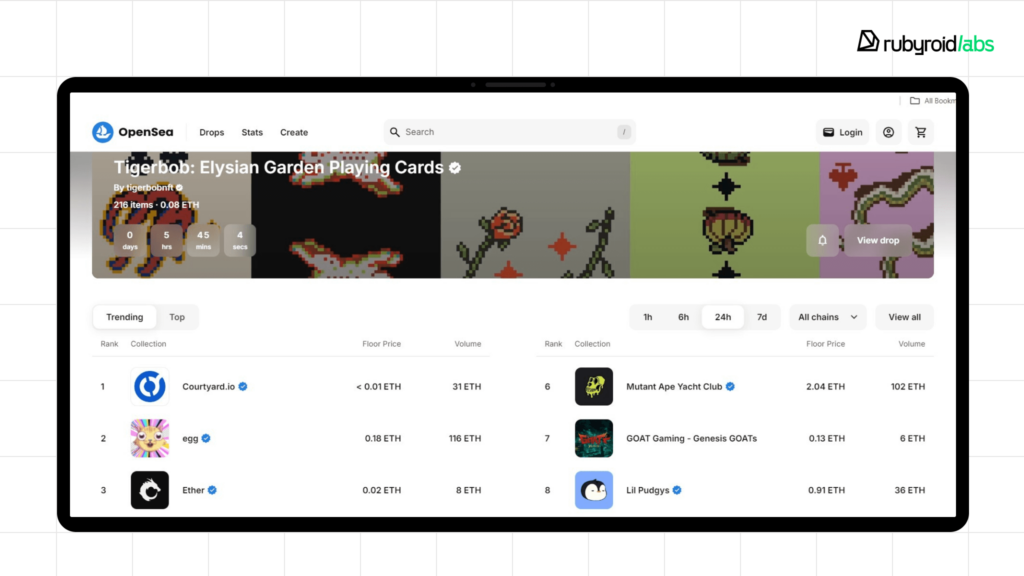
Preparing Your Business for Web3 Ecommerce: Steps to Take Now
While some brands have already started adapting their businesses for the approaching decentralized era of Web3, others are at the point of developing strategies.
We’ll look at the possible solutions you can implement now to lay the groundwork for a successful transition into the Web3 ecommerce landscape. Using at least one of them can elevate your business above competitors in this technological revolution.
Enable cryptocurrency payments
Include bitcoin payment choices in your checkout process. This not only appeals to cryptocurrency fans, but it may also result in higher order values and indicate your company’s dedication to financial innovation.
Create immersive metaverse experiences
Launching a virtual store or a showroom on one of the popular metaverse platforms is not just a step into revolutionizing online shopping. The space can offer interactive product demonstrations, virtual try-ons, and customizable experiences that sync with customers’ digital avatars. Such an approach will definitely boost customer engagement and satisfaction and provide a competitive edge.
Invest in blockchain-based supply chain solutions
Blockchain in supply chain management can increase transparency, traceability, and build loyalty and trust among customers who appreciate product origins and sustainability.
Implement token-gated commerce
You can also integrate blockchain and NFTs into your business model. By developing exclusive products, services, or content that can only be accessed by customers holding specific tokens or NFTs, you can build your own customer community and provide unique offers for different customer categories. This approach creates a unique value proposition and increases customer loyalty in the Web3 ecosystem.
Integrate AI solutions
AI and machine learning have already become popular in customer services across various spheres such as healthcare, sales, sports, automotive, and more. Integrating AI into your ecommerce store’s business processes automates many manual tasks like pricing, product storage, and developing marketing strategies on the one hand while offering hyper-personalized shopping experiences on the other. For example, ChatGPT can be implemented into the following sales and marketing tools:
- CRM systems
- e-commerce platforms
- social media and messaging apps
- analytics tools
- email marketing platforms
To learn more about how ChatGPT can be used in e-commerce, read in our post.
Gamify the shopping journey
Develop gamified aspects for your ecommerce business. This might include treasure hunting for exclusive discounts, NFT-based loyalty programs, or interactive challenges that access unique items or experiences. Gamification may improve retention of customers and attract younger, more tech-savvy consumers.
Invest in Web 3 education and skill development
Provide resources to teach your staff about Web3 technology and principles. Consider working with Web3 experts or employing professionals to help you navigate the transition and deployment of these new technologies.
Wrapping Up
As we see from the post, Web3 and ecommerce will march together in the future landscape.
It’s not just a trend but a fundamental shift that will expand and will cover more and more industries in the near future.
For you as a project owner, the use of Web3 ecommerce can bring three large advantages over your competitors:
- a more engaged audience seeking more personalized service and interactivity
- global reach due to the borderless transactions and their lower costs
- innovative marketing opportunities and automated processes
The team from Rubyroid Labs can help you choose the right Web 3.0 technology that will align with your business needs and plans. Our developers, with over 8 years of experience in web development, can share their expertise and professional view on which technologies will fit your project and enhance your business operations. Reach out to us, and we’ll create a robust plan and an estimate for your project.




